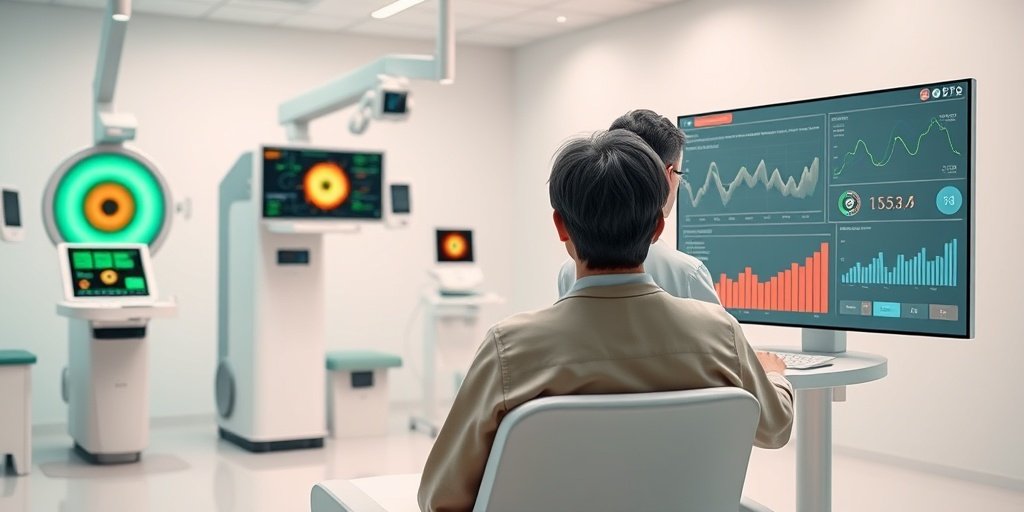⚡ Quick Summary
This review article discusses the role of immunomodulatory therapy (IMT) in managing non-infectious uveitis (NIU), highlighting the need for corticosteroid-sparing strategies and the challenges in treatment standardization. It emphasizes the potential of artificial intelligence and personalized approaches in improving patient outcomes.
🔍 Key Details
- 📊 Focus: Non-infectious uveitis (NIU) management
- 🧩 Therapies discussed: Antimetabolites, calcineurin inhibitors, biologics, small molecules
- ⚙️ Challenges: Standardization of tapering strategies, lack of remission-inducing treatments
- 🏆 Registries: PROTON and TOFU addressing treatment exit frameworks
- 🔍 Future directions: AI-guided prediction models, biomarker-driven therapy
🔑 Key Takeaways
- 🌟 IMT is central to managing chronic NIU while reducing corticosteroid use.
- ⚠️ Long-term corticosteroid use poses significant risks, necessitating alternative therapies.
- 📈 Emerging therapies include biologics and small molecules that show promise in treatment.
- 🧬 Personalized approaches and biomarker-driven therapies are on the horizon.
- 🤖 AI advancements may enable real-time disease monitoring and risk stratification.
- 📅 Structured treatment exit frameworks are being developed through recent registries.
- 🔄 Evidence for optimal combinations of therapies remains limited.
- 🌍 The study highlights the need for larger, well-annotated cohorts for AI analysis.

📚 Background
Non-infectious uveitis (NIU) is a serious inflammatory condition that can lead to vision loss. It may occur on its own or as part of systemic immune-mediated diseases. While corticosteroids are effective for quick inflammation control, their long-term use is fraught with significant side effects. This has led to a growing interest in immunomodulatory therapies that can provide sustained control with fewer risks.
🗒️ Study
The review article synthesizes current knowledge on the use of immunomodulatory therapy in NIU, focusing on the various treatment options available, including conventional immunosuppressants and newer biologic therapies. It also discusses the challenges faced in clinical practice, such as the lack of standardized tapering strategies and the need for effective remission-inducing treatments.
📈 Results
The findings underscore that while there are multiple therapeutic options for NIU, significant gaps remain in treatment protocols. The review highlights the importance of registries like PROTON and TOFU, which are beginning to address these gaps by providing structured frameworks for treatment exit and monitoring.
🌍 Impact and Implications
The implications of this review are profound. By emphasizing the need for corticosteroid-sparing strategies and the potential of personalized medicine, it paves the way for improved management of NIU. The integration of AI in monitoring and treatment could revolutionize how we approach this condition, ultimately leading to better patient outcomes and quality of life.
🔮 Conclusion
This review highlights the critical role of immunomodulatory therapy in managing non-infectious uveitis and the urgent need for standardized treatment protocols. With advancements in AI and personalized approaches, the future of NIU management looks promising. Continued research and collaboration will be essential in overcoming current challenges and improving patient care.
💬 Your comments
What are your thoughts on the future of immunomodulatory therapy in non-infectious uveitis? We would love to hear your insights! 💬 Join the conversation in the comments below or connect with us on social media:
Immunomodulatory Therapy in Non-Infectious Uveitis: Current Landscape, Gaps, and Future Directions.
Abstract
Non-infectious uveitis (NIU) is a potentially sight-threatening intraocular inflammatory condition that may arise idiopathically or in association with systemic immune-mediated diseases. While corticosteroids remain essential for rapid suppression of inflammation, their long-term use is limited by significant systemic and ocular side effects. Thus, immunomodulatory therapy (IMT)-including antimetabolites, calcineurin inhibitors, biologics, and emerging small molecules-has become central to achieving sustained control with reduced corticosteroid burden for the chronic cases. Despite a range of therapeutic options, major challenges persist. Safe, remission-inducing treatments remain elusive; tapering strategies are poorly standardized; and evidence for optimal combinations or long-term outcomes remains limited. Recent registries, such as Program for Ocular Inflammation and Infection Translational Research (PROTON) and Treatment Exit Options for Uveitis (TOFU), are beginning to address the unmet need for structured treatment exit frameworks. Moreover, advances in imaging and artificial intelligence may soon allow for real-time monitoring of disease status and risk stratification, although development of large, well-annotated cohorts to subject to such analysis remain a key hurdle. This review summarizes the current role of IMT in the management of NIU, with an emphasis on corticosteroid-sparing strategies. We highlight the use of conventional immunosuppressants-including antimetabolites, calcineurin inhibitors, and alkylating agents-as well as newer biologic, small molecule, and interferon-based therapies. We outline where IMT fits within the broader treatment algorithm, discuss emerging evidence for earlier initiation, and explore future directions in targeted and personalized immunotherapy. We also explore future directions including personalized approaches, biomarker-driven therapy, and the promise of AI-guided prediction models.
Author: [‘Agrawal R’, ‘Goh YY’, ‘Rojas-Carabali W’, ‘Cifuentes Gonzalez CH’, ‘Srinivasan S’, ‘Yu-Hor Thong B’, ‘de-la-Torre A’, ‘Samson CM’, ‘Biswas J’, ‘Finger RP’, ‘Kempen JH’]
Journal: Prog Retin Eye Res
Citation: Agrawal R, et al. Immunomodulatory Therapy in Non-Infectious Uveitis: Current Landscape, Gaps, and Future Directions. Immunomodulatory Therapy in Non-Infectious Uveitis: Current Landscape, Gaps, and Future Directions. 2025; (unknown volume):101380. doi: 10.1016/j.preteyeres.2025.101380